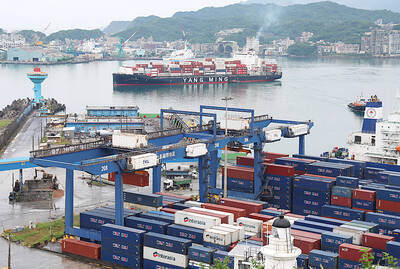Taiwanese who back a planned trade pact with China and those who oppose it agree on one thing at least — the agreement will have a major impact on the nation’s labor market.
While those in favor of the much-anticipated deal with Taiwan’s giant neighbor say there will be massive gains, others fear it will wipe out jobs on a huge scale.
No one knows for sure what the consequences will be but the uncertainty unsettles those whose livelihoods may be at risk from the mainland’s millions of underpaid workers.
“I’m in the dark and I’m afraid my job will be affected,” said a Taiwanese auto worker, who only wanted to be identified by his surname Wu.
“I don’t know what the agreement is about at all, because the government has failed to give the full details,” Wu said.
During Taiwan’s boom years from the 1960s to the 1990s, unemployment was seldom on the agenda, but now it has emerged as a decisive political issue.
So far this year the jobless rate has been 5.82 percent, nearly double the 2.99 percent recorded as late as in 2000.
The government insists the trade pact with China, referred to as an economic cooperation framework agreement (ECFA) will boost the flow of goods and personnel, raising annual economic growth by more than one percentage point.
Taiwan and China will reportedly hold informal talks this week on the trade pact — the fourth such meeting, which will aim for a timetable for formal negotiations.
Ahead of the talks, the Taiwanese government has suggested that more than a quarter of a million jobs will be created by the agreement on a net basis.
“It’s like a rose,” Premier Wu Den-yih (吳敦義) said on Friday. “Optimists see the flower, while pessimists see the thorns. The government has to look at both the flower and the thorns.”
The flower, according to Wu, is 350,000 new jobs, especially in chemicals, machinery and textiles, while the thorns are more than 80,000 jobs at risk in industries such as tiles and home electronics.
“The estimate of 80,000 affected workers is the worst-case scenario,” an official at the Council of Labor Affairs said.
“They won’t necessarily all lose their jobs. Some will just receive on-the-job training and their employers will have to streamline to enhance competitiveness,” the official said.
However, some analysts called the 80,000 figure unrealistically low, given the country’s labor force of more than 10 million.
“What if more industries relocate to China for lower production costs once the pact is signed? That will really hit the job market here,” Mega Securities (兆豐證券) analyst Lucas Lee (李志安) said.
Kenneth Lin (林向愷), an economist at National Taiwan University, said the flow of Taiwanese investment to China — up from 0.5 percent of the GDP in 2000 to 2.6 percent last year — had a clear impact on jobs.
“With more investors moving to China, our jobless rate has averaged 4 [percent] to 5 percent between 2000 and 2008, up from two to three percent in the 1990s,” he said.
“I expect 150,000 to 200,000 workers will lose their jobs due to the pact,” he said.
Chinese Nationalist Party (KMT) legislator and management professor at Chengchi University Lai Shyh-bao (賴士葆) said the focus on the relationship with China was too narrow, pointing out the pact’s potentially beneficial impact on ties with other economies.
“The pact is likely to attract foreign investors to Taiwan as they expect to benefit from the integration with China,” he said.
“Increasing foreign investments are expected to create job openings to locals,” Lai said.

Taiwan’s exports soared 56 percent year-on-year to an all-time high of US$64.05 billion last month, propelled by surging global demand for artificial intelligence (AI), high-performance computing and cloud service infrastructure, the Ministry of Finance said yesterday. Department of Statistics Director-General Beatrice Tsai (蔡美娜) called the figure an unexpected upside surprise, citing a wave of technology orders from overseas customers alongside the usual year-end shopping season for technology products. Growth is likely to remain strong this month, she said, projecting a 40 percent to 45 percent expansion on an annual basis. The outperformance could prompt the Directorate-General of Budget, Accounting and

Two Chinese chipmakers are attracting strong retail investor demand, buoyed by industry peer Moore Threads Technology Co’s (摩爾線程) stellar debut. The retail portion of MetaX Integrated Circuits (Shanghai) Co’s (上海沐曦) upcoming initial public offering (IPO) was 2,986 times oversubscribed on Friday, according to a filing. Meanwhile, Beijing Onmicro Electronics Co (北京昂瑞微), which makes radio frequency chips, was 2,899 times oversubscribed on Friday, its filing showed. The bids coincided with Moore Threads’ trading debut, which surged 425 percent on Friday after raising 8 billion yuan (US$1.13 billion) on bets that the company could emerge as a viable local competitor to Nvidia

BARRIERS: Gudeng’s chairman said it was unlikely that the US could replicate Taiwan’s science parks in Arizona, given its strict immigration policies and cultural differences Gudeng Precision Industrial Co (家登), which supplies wafer pods to the world’s major semiconductor firms, yesterday said it is in no rush to set up production in the US due to high costs. The company supplies its customers through a warehouse in Arizona jointly operated by TSS Holdings Ltd (德鑫控股), a joint holding of Gudeng and 17 Taiwanese firms in the semiconductor supply chain, including specialty plastic compounds producer Nytex Composites Co (耐特) and automated material handling system supplier Symtek Automation Asia Co (迅得). While the company has long been exploring the feasibility of setting up production in the US to address

OPTION: Uber said it could provide higher pay for batch trips, if incentives for batching is not removed entirely, as the latter would force it to pass on the costs to consumers Uber Technologies Inc yesterday warned that proposed restrictions on batching orders and minimum wages could prompt a NT$20 delivery fee increase in Taiwan, as lower efficiency would drive up costs. Uber CEO Dara Khosrowshahi made the remarks yesterday during his visit to Taiwan. He is on a multileg trip to the region, which includes stops in South Korea and Japan. His visit coincided the release last month of the Ministry of Labor’s draft bill on the delivery sector, which aims to safeguard delivery workers’ rights and improve their welfare. The ministry set the minimum pay for local food delivery drivers at